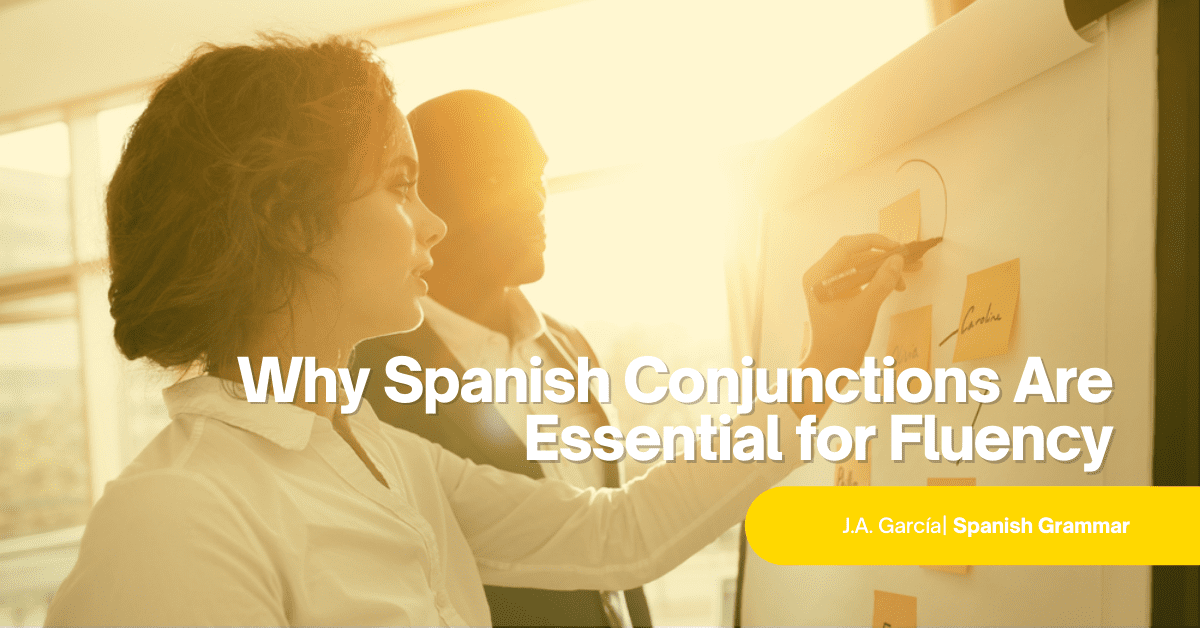
Connecting the Dots: Why Spanish Conjunctions Are Essential for Fluency
If you’re learning Spanish, you should know that Spanish conjunctions are a big deal!
Today we’ll show you everything you need to know about them, how to use them, and why paying attention to them is important when you practice Spanish.
Spanish grammar can be overwhelming, mainly because there are many variants that we don’t use in English.
But once you understand how grammar rules work, you’ll be able to have more fluid communication.
Stay with us and learn everything you need to improve your Spanish language skills.
Join 559 million people on the planet who speak Spanish!
Sign up for your free trial Spanish class today.

What Are Conjunctions?
Conjunctions are words used to connect sentences or words to give continuity to an idea. These allow you to shape and provide coherence to your texts.
The main characteristic of conjunctions is that they’re always written similarly since they don’t have a gender.
But why do conjunctions make Spanish more fluent?
These words make the language work correctly, which makes Spanish’s grammatical structure different from English.
Using them will help you so that you don’t sound like a robot or Tarzan.
For example: “My mother is tall. My father is short. That’s not a problem” It sounds good the sentences don’t flow naturally.
With conjunctions, they sound better: “My mother is tall, and my father is short, but that’s not a problem.”
See the difference?
Knowing connective words will help you express yourself. In addition, your confidence will increase because you’ll have high-level conversations, and native Spanish speakers will understand you more easily.
Also, don’t miss The Essential Guide to Spanish Linking Words to become an expert in Spanish conjunction words.
Types of Spanish Conjunctions
Remember that some conjunctions in Spanish don’t have a specific meaning as they vary depending on the context of the text.
This is why it’s important to know how each conjunction works and how to use it daily.
Join us to learn the types of conjunctions and connectors in Spanish and examples of how to apply them in your conversations.
Coordinating Conjunctions in Spanish
These conjunctions are those that link words or sentences so phrases can be swapped without losing their meaning.
So, if you say, “We bought onions and carrots,” you can also say, “We bought carrots and onions,” and the sentence’s meaning is the same.
Coordinating conjunctions are divided into different types:
Additive Conjunctions
These words allow to join a single sentence or two elements of the same type, indicating a sum of the items listed. These are: y, e, ni, que.
Examples:
You’ll use the conjunction y to add one word to the other, but if the following word starts with the sound i, you’ll use the conjunction e instead.
Mi papá y mi mamá se fueron del país.
My father and mother left the country.
You use the conjunction ni to add elements, but the final meaning is negative.
Ni a mi hermano ni a mi hermana les gusta ver fútbol.
Neither my brother nor my sister like to watch football.
The conjunction que is used when you want to indicate that an action is happening for a long time or to exaggerate it.
Hoy ha estado llueve que llueve sin parar.
Today it’s been raining non-stop.
Disjunctive Conjunctions
These words help you join two terms to offer an alternative in which one of the two must be chosen.
These are: o and u.
Examples:
Te comes la comida o no juegas videojuegos.
You eat your food or you can’t play video games.
We use u instead of o when the following word starts with the sound o. For example, it may begin with the letter o or with ho.
Puede ser de plata u oro. Ella no tiene preferencias.
It can be silver or gold. She has no preferences.
Adversative Conjunctions
These words allow you to put together two terms that contradict each other.
These are: pero, mas, sin embargo, aunque, sino, no obstante, con todo, más bien, excepto, salvo, a pesar, menos.
Here are some examples:
Pero implies restriction.
Tengo dinero, pero no quiero gastarlo.
I have money, but I don’t want to spend it.
Sino expresses the incompatibility of the two elements so that the second element excludes the first one. The first one will always be negative.
Miguel no rompió la ventana, sino fue Claudia.
Miguel didn’t break the window, but Claudia did.
Mi papá me dio permiso para ir a la fiesta, a pesar de mi mal comportamiento.
My dad gave me permission to go to the party, despite my bad behavior.
Explanatory Conjunctions
These words allow you to put together terms that mean the same thing, but they give a better explanation when they’re together.
These are: o sea, esto es, es decir, mejor dicho.
When you write them, you must place them between commas.
Examples:
Mi hermano tiene mal aliento, es decir, no se lava bien la boca.
My brother has bad breath, that is, he doesn’t wash his mouth well.
El problema ya no está, o mejor dicho, yo lo resolví.
The problem is no longer there, or rather, I solved it.
Distributive Conjunctions
These words link two or more phrases, sentences, or words and are placed before each element, presenting them as possible options.
These are: bien… bien, ya… ya, ora… ora, o sea… sea, tanto… como.
These are some examples:
Ellos siempre se están peleando, sea que les guste, sea que no.
They’re always fighting, whether they like it or not.
A mí me gusta el chocolate, tanto el blanco, como el oscuro.
I like chocolate, both white and dark.
If you want to review these words in Spanish, check out these 9 Coordinating Conjunctions in Spanish Essential to Know.

Subordinating Conjunctions in Spanish
These conjunctions join propositions or sentences that are not interchangeable with each other since they establish a specific meaning when they’re put together.
They’re classified according to the role they play within the main sentence.
Causal Conjunctions
These words are used to establish the reason or consequence of the action in the sentence.
These are: como, dado que, porque, pues, puesto que, visto que, ya que.
Examples:
No fui al trabajo porque estaba enferma de la gripe.
I didn’t go to work because I was sick with the flu.
Aplicaré a un nuevo trabajo, visto que no me han aceptado en otros lugares.
I’ll apply for a new job since I haven’t been accepted elsewhere.
Comparative Conjunctions
These words establish a comparison in the sentence.
These are: que, como si, sin que, menos que, igual que, peor que, cual, así como.
Examples:
Mi hermana se ríe como mi mamá.
My sister laughs like my mom.
Puedes hacer ejercicios sin que sea aburrido.
You can do exercises without it being boring.
Conditional Conjunctions
These words establish a conditional relationship in the sentence. It means that one thing will be fulfilled if and when the other is too.
These are: si, pero si, con tal que, siempre que, a condición de que.
Examples:
Te daré un regalo si ordenas tu cuarto toda la semana.
I’ll give you a gift if you tide up your room all week.
Estoy dispuesta a renunciar con tal que me den el bono de recompensa.
I’m willing to quit if they give me the reward bonus.
Consecutive or Illative Conjunctions
These words provide information as a result of the action in the text.
These are: por lo tanto, de modo que, así que, pues bien, de manera que, tanto que, con que.
Examples:
El perro se enfermó así que tuve que llevarlo al veterinario.
The dog got sick, so I had to take him to the vet.
Hacía mucho calor en la casa por lo tanto tuve que conectar el aire acondicionado.
It was very hot in the house, therefore, I had to turn on the air conditioning.
Temporal Conjunctions
They express a temporal relationship of posterity, simultaneity, etc., in the sentence.
These are: cuando, tan pronto, antes que, luego de que, mientras, cada vez que.
Examples:
Mi hermano empieza a roncar tan pronto se queda dormido.
My brother starts snoring as soon as he falls asleep.
Mariana escucha música mientras hace la limpieza de la casa.
Mariana listens to music while cleaning the house.
Purpose Conjunctions
These words are used to link to create a purpose between both parts of the sentence.
These are: para que, a fin de que, para, con el fin de que, en miras a, con vista a.
Examples:
La empresa contrató más personal a fin de que el trabajo se realice con mejor calidad.
The company hired more staff so that the work is done with better quality.
Se inauguró una nueva clínica con el fin de que más personas reciban atención médica.
A new clinic was inaugurated in order for more people to receive medical attention.
Concessive Conjunctions
These words are used to grant or accept the action proposed in the sentence.
These are: por más que, aunque, aún cuando, a pesar de, si bien.
Examples:
Te acompañaré al estadio aún cuando no soy fanática del baseball.
I’ll walk you to the stadium even though I’m not a baseball fan.
Le hablaré a Ligia para pedirle consejo a pesar de su mala actitud.
I’ll speak to Ligia for advice despite her bad attitude.
If you want more detail about how to use these words, read these 9 types of subordinating conjunctions in Spanish that will supercharge your fluency.
Common Mistakes and How to Avoid Them
As you read above, an extensive list of Spanish conjunctions is used for different purposes, so it’s important to identify each one based on its category and sentence type.
For this, we suggest that you practice conjunctions in writing.
Writing them down and then reading them out loud will help you identify and make comparisons between them.
As a beginner student, you’ll realize that you write very short sentences in Spanish. This is where the conjunctions will help you.
When you speak in short phrases, try to include connectives in Spanish to make more complex sentences and thus sound more natural.
Use them whenever you can!
But be careful not to overuse them, as others will have a hard time understanding what you’re saying. Try to stick to one or two per sentence.
Achieve Your Spanish Fluency With Spanish Conjunctions!
If you made it this far, you’re now maybe an expert on conjunctions in Spanish!
You’ll realize how your learning level will go from basic vocabulary to using conjunctions in Spanish to reach your language proficiency.
So, start using them as soon as you can!
Practice them in your journal, talk to your Spanish teacher, and teach your classmates by example.
If you want to learn Spanish with native, authentic Spanish instruction, Homeschool Spanish Academy it’s your best option!
We have student-tailored Spanish programs with a first-rate, expert curriculum.
Sign up here for your free trial class with a real human connection.
We’ve been teaching Spanish for over 10 years, so click here to check our prices and programs available for all ages.
Your future is waiting for you!

Join one of the 40,000 classes that we teach each month and you can experience results like these…

“This is the best way for your kid to learn Spanish. It’s one-on-one, taught by native Spanish speakers, and uses a curriculum.”
– Sharon K, Parent of 3

“It’s a great way to learn Spanish, from native Spanish speakers in a 1-on-1 environment. It’s been fairly easy to schedule classes around my daughter’s other classes. The best value for us has been ordering multiple classes at a time. All the instructors have been great!”
– Cindy D, Parent of 3

“HSA offers very affordable, quality, one on one classes with a native speaker. My son has greatly benefited from taking classes. We have seen his confidence increase as well as his pronunciation improve, because he learns from a native Spanish speaker. HSA has quick, personal customer service. Our family has been very pleased with our experience so far!”
– Erica P. Parent of 1
Ready to learn more Spanish grammar and vocabulary? Check these out!
- The 25 Most Useful Spanish Phrases You Need to Lear Today
- 50 Useful Spanish Transition Words for Everyday Speech and Writing
- Master the 18 Spanish Tenses (and Take Our Cheat Sheet With You)
- All About Adverbial Clauses in Spanish
- Top 20 Guatemalan Words and Slang Expressions You Should Know
- The Ultimate Guide to the Differences Between ‘Pero’ and ‘Sino’ in Spanish
- A Guide to Double Negatives in Spanish
- Ver Conjugation: Free Spanish Lesson, Exercises, and PDF
- What Does it Actually Take to Become Fluent in Spanish? - August 29, 2024
- Learn About Hispanic History: Were Hispanics Slaves? - May 30, 2024
- Turn Your Life Around: From Passive Bilingualism to Fluency! - April 4, 2024








